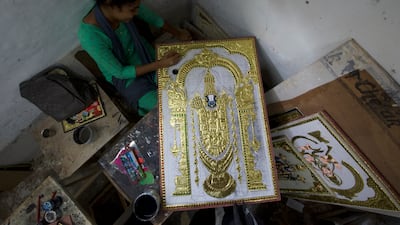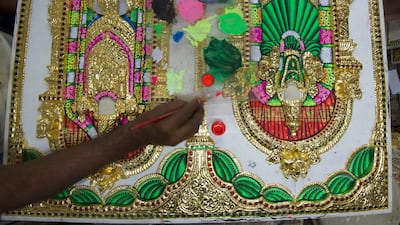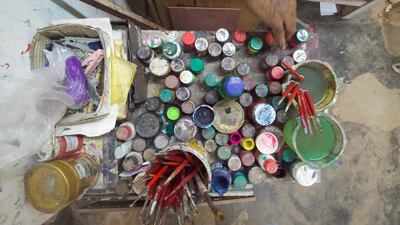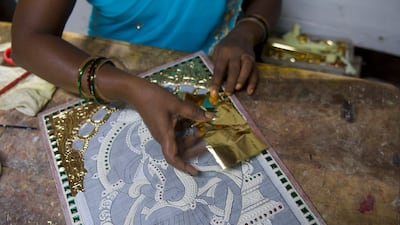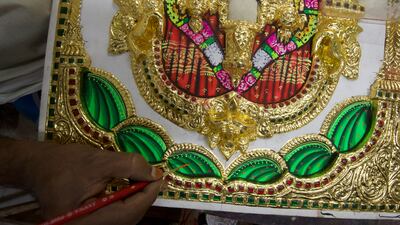In a traditional two-room house surrounded by towering coconut trees in southern Indian, a new generation of dedicated artists are keeping alive a centuries-old skill of blending paint and gold to create ornate paintings of Hindu deities.
Tanjore paintings, as they are known to the world, have survived the vagaries of time in the narrow lanes of Thanjavur district, Tamil Nadu, where a handful of artists painstakingly lay 22-carat gold foil over their drawings to enhance their richness and achieve a glittery effect, before applying strokes of paint.
Several gleaming paintings – some up to 152cm tall – are carefully propped up or hung on the walls of this studio.
They represent a 16th-century classical art form known for its detailed depictions of Hindu deities. The tradition originated under the Vijayanagara Empire that ruled the region from the 13th century to the 16th century.
The rulers of the empire were keen patrons of art and culture and heavily promoted the paintings, which were initially used to decorate temples, palaces and homes.
“It started 400 to 500 years ago ... We have been doing this work generation after generation. This is family work,” Kathirvel, who runs the studio, called The Art Village, told The National.
“We use real gold. In the older days, gold was cheap but we are still using pure 22-carat,” he said.
Kathirvel, 54, is a fourth-generation Tanjore artist. His great-grandfather, grandfather and father Nadesan, 83, now retired, were all devoted to the craft.
He learnt the ropes from his father at the age of 15 and is now passing down the knowledge to his only son, Aravind, 28, a mechanical engineer.
Elaborate
Tanjore paintings are an elaborate and expensive affair. A single painting can take up to three weeks to complete, depending on the size, complexity and intricacy.
The process is extravagant, time-consuming and detailed as it includes a combination of carving, embossing, colouring and, eventually, the application of gold leaf that adds depth, Kathirvel said.
The artists begin by carving the shape of the deity or their subject on boards made from teak or jackfruit wood. This is where the art form derives its Tamil name, palagai padam, which means “picture on a wooden plank”.
Next comes embossing, traditionally with gesso – a mixture of edible gum, chalk powder, limestone and tamarind paste. The painting is then laid outside for two days to dry, before the gold is laid.
Artists use 22-carat gold foil on the embossed parts of the canvas to enhance the richness of the artwork and achieve a shiny effect.
They cuts sheets of foil with a razor and lay them down on glue. Cut glass and precious stones are carefully arranged to create elaborate patterns, which further enhance the beauty and complexity of the piece.
The final step involves adding colour, traditionally with natural dyes made from flowers and leaves. However, poster paints are more commonly used today, Kathirvel said.
“Hibiscus for red, eggplant skin for violet, turmeric for yellow … we spent days making the pigments,” he said, demonstrating on a sheet of paper.
“We still use the natural pigment on special request but it increases the cost of the painting as it takes more time. One painting, if small, can take seven to 10 days to complete and a big one can take up to 20 days.”
The cost of each ranges from 4,000 rupees ($48) to 200,000 rupees ($2,800).
Popularity
Although the rich and priestly class were initially the patrons of Tanjore paintings, the artworks have surprisingly found favour among India's booming middle class in recent years, with passionate collectors striving to preserve the tradition.
While many older Tanjore artists are retiring, younger creators such as Aravind are working to keep the tradition alive.
“I was not very interested but after finishing my education, I started learning the skill from my father. After three years, I joined his business. It is time-consuming but it is a profitable business,” Aravind said.
"I did not want to but I had to learn as this is generational work for my family."
The paintings, especially big ones, are not sold regularly but Aravind said they get bulk orders from sellers in other parts of the country and also sell smaller pieces on social media.
"We manage to sell about 10 a month. Most of the people like to keep the paintings in prayer rooms,” he said.
“These are lifelong and after 50 years, the gold gives the paintings an antique look. It is a one-time investment. The value only increases with time.”
Kathirvel said the amount of time needed to create the paintings could be a deterrent to some artists but he is hopeful the art form will survive, given the steady demand.
“I am hopeful that the next generation will have the patience and dedication to learn this and carry it forward.”
BUNDESLIGA FIXTURES
Saturday, May 16 (kick-offs UAE time)
Borussia Dortmund v Schalke (4.30pm)
RB Leipzig v Freiburg (4.30pm)
Hoffenheim v Hertha Berlin (4.30pm)
Fortuna Dusseldorf v Paderborn (4.30pm)
Augsburg v Wolfsburg (4.30pm)
Eintracht Frankfurt v Borussia Monchengladbach (7.30pm)
Sunday, May 17
Cologne v Mainz (4.30pm),
Union Berlin v Bayern Munich (7pm)
Monday, May 18
Werder Bremen v Bayer Leverkusen (9.30pm)
Company%20profile%20
%3Cp%3E%3Cstrong%3EName%3A%20%3C%2Fstrong%3EYodawy%3Cbr%3E%3Cstrong%3EBased%3A%3C%2Fstrong%3E%20Egypt%3Cbr%3E%3Cstrong%3EFounders%3A%20%3C%2Fstrong%3EKarim%20Khashaba%2C%20Sherief%20El-Feky%20and%20Yasser%20AbdelGawad%3Cstrong%3E%3Cbr%3ESector%3A%20%3C%2Fstrong%3EHealthTech%3Cbr%3E%3Cstrong%3ETotal%20funding%3A%20%3C%2Fstrong%3E%2424.5%20million%3Cbr%3E%3Cstrong%3EInvestors%3A%20%3C%2Fstrong%3EAlgebra%20Ventures%2C%20Global%20Ventures%2C%20MEVP%20and%20Delivery%20Hero%20Ventures%2C%20among%20others%3Cstrong%3E%3Cbr%3ENumber%20of%20employees%3A%3C%2Fstrong%3E%20500%3Cbr%3E%3C%2Fp%3E%0A
PAKISTAN SQUAD
Abid Ali, Fakhar Zaman, Imam-ul-Haq, Shan Masood, Azhar Ali (test captain), Babar Azam (T20 captain), Asad Shafiq, Fawad Alam, Haider Ali, Iftikhar Ahmad, Khushdil Shah, Mohammad Hafeez, Shoaib Malik, Mohammad Rizwan (wicketkeeper), Sarfaraz Ahmed (wicketkeeper), Faheem Ashraf, Haris Rauf, Imran Khan, Mohammad Abbas, Mohammad Hasnain, Naseem Shah, Shaheen Afridi, Sohail Khan, Usman Shinwari, Wahab Riaz, Imad Wasim, Kashif Bhatti, Shadab Khan and Yasir Shah.
SPEC%20SHEET%3A%20APPLE%20M3%20MACBOOK%20AIR%20(13%22)
%3Cp%3E%3Cstrong%3EProcessor%3A%3C%2Fstrong%3E%20Apple%20M3%2C%208-core%20CPU%2C%20up%20to%2010-core%20CPU%2C%2016-core%20Neural%20Engine%3C%2Fp%3E%0A%3Cp%3E%3Cstrong%3EDisplay%3A%3C%2Fstrong%3E%2013.6-inch%20Liquid%20Retina%2C%202560%20x%201664%2C%20224ppi%2C%20500%20nits%2C%20True%20Tone%2C%20wide%20colour%3C%2Fp%3E%0A%3Cp%3E%3Cstrong%3EMemory%3A%3C%2Fstrong%3E%208%2F16%2F24GB%3C%2Fp%3E%0A%3Cp%3E%3Cstrong%3EStorage%3A%3C%2Fstrong%3E%20256%2F512GB%20%2F%201%2F2TB%3C%2Fp%3E%0A%3Cp%3E%3Cstrong%3EI%2FO%3A%3C%2Fstrong%3E%20Thunderbolt%203%2FUSB-4%20(2)%2C%203.5mm%20audio%2C%20Touch%20ID%3C%2Fp%3E%0A%3Cp%3E%3Cstrong%3EConnectivity%3A%3C%2Fstrong%3E%20Wi-Fi%206E%2C%20Bluetooth%205.3%3C%2Fp%3E%0A%3Cp%3E%3Cstrong%3EBattery%3A%3C%2Fstrong%3E%2052.6Wh%20lithium-polymer%2C%20up%20to%2018%20hours%2C%20MagSafe%20charging%3C%2Fp%3E%0A%3Cp%3E%3Cstrong%3ECamera%3A%3C%2Fstrong%3E%201080p%20FaceTime%20HD%3C%2Fp%3E%0A%3Cp%3E%3Cstrong%3EVideo%3A%3C%2Fstrong%3E%20Support%20for%20Apple%20ProRes%2C%20HDR%20with%20Dolby%20Vision%2C%20HDR10%3C%2Fp%3E%0A%3Cp%3E%3Cstrong%3EAudio%3A%3C%2Fstrong%3E%204-speaker%20system%2C%20wide%20stereo%2C%20support%20for%20Dolby%20Atmos%2C%20Spatial%20Audio%20and%20dynamic%20head%20tracking%20(with%20AirPods)%3C%2Fp%3E%0A%3Cp%3E%3Cstrong%3EColours%3A%3C%2Fstrong%3E%20Midnight%2C%20silver%2C%20space%20grey%2C%20starlight%3C%2Fp%3E%0A%3Cp%3E%3Cstrong%3EIn%20the%20box%3A%3C%2Fstrong%3E%20MacBook%20Air%2C%2030W%2F35W%20dual-port%2F70w%20power%20adapter%2C%20USB-C-to-MagSafe%20cable%2C%202%20Apple%20stickers%3C%2Fp%3E%0A%3Cp%3E%3Cstrong%3EPrice%3A%3C%2Fstrong%3E%20From%20Dh4%2C599%3C%2Fp%3E%0A
3%20Body%20Problem
%3Cp%3E%3Cstrong%3ECreators%3A%3C%2Fstrong%3E%20David%20Benioff%2C%20D%20B%20Weiss%2C%20Alexander%20Woo%3C%2Fp%3E%0A%3Cp%3E%3Cstrong%3EStarring%3A%20%3C%2Fstrong%3EBenedict%20Wong%2C%20Jess%20Hong%2C%20Jovan%20Adepo%2C%20Eiza%20Gonzalez%2C%20John%20Bradley%2C%20Alex%20Sharp%3C%2Fp%3E%0A%3Cp%3E%3Cstrong%3ERating%3A%3C%2Fstrong%3E%203%2F5%3C%2Fp%3E%0A
VEZEETA PROFILE
Date started: 2012
Founder: Amir Barsoum
Based: Dubai, UAE
Sector: HealthTech / MedTech
Size: 300 employees
Funding: $22.6 million (as of September 2018)
Investors: Technology Development Fund, Silicon Badia, Beco Capital, Vostok New Ventures, Endeavour Catalyst, Crescent Enterprises’ CE-Ventures, Saudi Technology Ventures and IFC
The%20specs
%3Cp%3E%3Cstrong%3EEngine%3A%3C%2Fstrong%3E%201.8-litre%204-cyl%20turbo%0D%3Cbr%3E%3Cstrong%3EPower%3A%20%3C%2Fstrong%3E190hp%20at%205%2C200rpm%0D%3Cbr%3E%3Cstrong%3ETorque%3A%3C%2Fstrong%3E%20320Nm%20from%201%2C800-5%2C000rpm%0D%3Cbr%3E%3Cstrong%3ETransmission%3A%20%3C%2Fstrong%3ESeven-speed%20dual-clutch%20auto%0D%3Cbr%3E%3Cstrong%3EFuel%20consumption%3A%3C%2Fstrong%3E%206.7L%2F100km%0D%3Cbr%3E%3Cstrong%3EPrice%3A%3C%2Fstrong%3E%20From%20Dh111%2C195%0D%3Cbr%3E%3Cstrong%3EOn%20sale%3A%20%3C%2Fstrong%3ENow%3C%2Fp%3E%0A
Kanye%20West
%3Cp%3EYe%20%E2%80%94%20the%20rapper%20formerly%20known%20as%20Kanye%20West%20%E2%80%94%20has%20seen%20his%20net%20worth%20fall%20to%20%24400%20million%20in%20recent%20weeks.%20That%E2%80%99s%20a%20precipitous%20drop%20from%20Bloomberg%E2%80%99s%20estimates%20of%20%246.8%20billion%20at%20the%20end%20of%202021.%3Cbr%3EYe%E2%80%99s%20wealth%20plunged%20after%20business%20partners%2C%20including%20Adidas%2C%20severed%20ties%20with%20him%20on%20the%20back%20of%20anti-Semitic%20remarks%20earlier%20this%20year.%3Cbr%3EWest%E2%80%99s%20present%20net%20worth%20derives%20from%20cash%2C%20his%20music%2C%20real%20estate%20and%20a%20stake%20in%20former%20wife%20Kim%20Kardashian%E2%80%99s%20shapewear%20firm%2C%20Skims.%3C%2Fp%3E%0A
Silent Hill f
Publisher: Konami
Platforms: PlayStation 5, Xbox Series X/S, PC
Rating: 4.5/5
Labour dispute
The insured employee may still file an ILOE claim even if a labour dispute is ongoing post termination, but the insurer may suspend or reject payment, until the courts resolve the dispute, especially if the reason for termination is contested. The outcome of the labour court proceedings can directly affect eligibility.
- Abdullah Ishnaneh, Partner, BSA Law
'Worse than a prison sentence'
Marie Byrne, a counsellor who volunteers at the UAE government's mental health crisis helpline, said the ordeal the crew had been through would take time to overcome.
“It was worse than a prison sentence, where at least someone can deal with a set amount of time incarcerated," she said.
“They were living in perpetual mystery as to how their futures would pan out, and what that would be.
“Because of coronavirus, the world is very different now to the one they left, that will also have an impact.
“It will not fully register until they are on dry land. Some have not seen their young children grow up while others will have to rebuild relationships.
“It will be a challenge mentally, and to find other work to support their families as they have been out of circulation for so long. Hopefully they will get the care they need when they get home.”
How has net migration to UK changed?
The figure was broadly flat immediately before the Covid-19 pandemic, standing at 216,000 in the year to June 2018 and 224,000 in the year to June 2019.
It then dropped to an estimated 111,000 in the year to June 2020 when restrictions introduced during the pandemic limited travel and movement.
The total rose to 254,000 in the year to June 2021, followed by steep jumps to 634,000 in the year to June 2022 and 906,000 in the year to June 2023.
The latest available figure of 728,000 for the 12 months to June 2024 suggests levels are starting to decrease.





